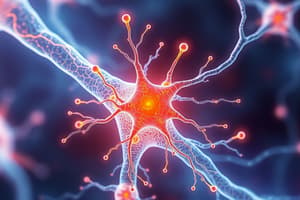Podcast
Questions and Answers
What is the role of dendrites in a neuron?
What is the role of dendrites in a neuron?
- To release neurotransmitters into the synapse
- To create the myelin sheath
- To receive data from other neurons (correct)
- To send electric signals down the axon
What is an action potential?
What is an action potential?
- The time during which the ion channels are closed
- The resting state of the neuron at -70 mV
- The process of neurotransmitter release
- The rapid change in voltage when a neuron is stimulated (correct)
Which neurotransmitter is considered the primary excitatory transmitter?
Which neurotransmitter is considered the primary excitatory transmitter?
- GABA
- Dopamine
- Glutamate (correct)
- Serotonin
What occurs during the refractory period of a neuron?
What occurs during the refractory period of a neuron?
How do psychoactive drugs affect neurotransmitter activity?
How do psychoactive drugs affect neurotransmitter activity?
What does heritability indicate in behavioral genetics?
What does heritability indicate in behavioral genetics?
What defines an allele?
What defines an allele?
Which of the following statements about the synapse is accurate?
Which of the following statements about the synapse is accurate?
Flashcards are hidden until you start studying
Study Notes
Neuron Structure
- Glia: Support cells responsible for creating myelin sheath, which insulates axons.
- Dendrite: Receives signals from other neurons.
- Axon: Transmits electrical signals.
- Terminal branches: Release neurotransmitters into the synapse.
Neuronal Communication
- Electrical and Chemical Signaling:
- Electrical: Changes in voltage within the neuron, traveling from dendrites, down the axon, to the terminals.
- Chemical: Neurotransmitters released from terminal branches, crossing the synapse to bind with receptors on the dendrites of the next neuron.
Electrical Signals
- Action Potential (AP): Rapid change in voltage within a neuron caused by stimulation exceeding a critical threshold.
- Resting Potential (RP): Neuron is negatively polarized (-70 mV).
- Depolarization: Sufficient stimulation at the dendrite opens ion channels, allowing sodium ions (Na+) to enter, making the neuron more positive.
- Repolarization: Potassium ions (K+) leave the neuron, returning it to a negative charge.
- Refractory Period: Short period after an AP when the neuron is unable to fire another AP as it returns to resting potential.
- All-or-None Principle: An AP is fired once the resting potential threshold is met.
- Excitatory Signals: Promote the firing of an AP.
- Inhibitory Signals: Prevent or decrease the likelihood of an AP.
Chemical Signals
- Neurotransmission: Chemical communication between neurons.
- Amino Acids:
- Glutamate: Primary excitatory neurotransmitter, triggering APs.
- GABA: Primary inhibitory neurotransmitter, preventing APs.
- Monoamines:
- Norepinephrine: Involved in the "fight or flight" response.
- Dopamine: Associated with reward and pleasure.
- Serotonin: Contributes to mood regulation.
- Acetylcholine: Involved in muscle control, learning, and memory.
- Amino Acids:
- Synapse: The space between the terminal branches of the sending neuron and the dendrites of the receiving neuron.
- Receptors: Specific proteins on the dendrites that bind to specific neurotransmitters.
Artificial Transmission
- Psychoactive Drugs: Influence neurotransmitter activity.
- Agonist: Mimics the action of a neurotransmitter.
- Antagonist: Blocks neurotransmission.
Genes and Environment
- Allele: Variant of a gene, with two alleles inherited from each parent (one dominant, one recessive).
- Epigenetics: Study of how the environment can influence gene expression.
Behavioral Genetics
- Behavioral Genetics: Investigates how genetic factors contribute to variations in traits among individuals within a population.
- Heritability: A measure of how much variation in a phenotype can be attributed to genetic differences.
Studying That Suits You
Use AI to generate personalized quizzes and flashcards to suit your learning preferences.




